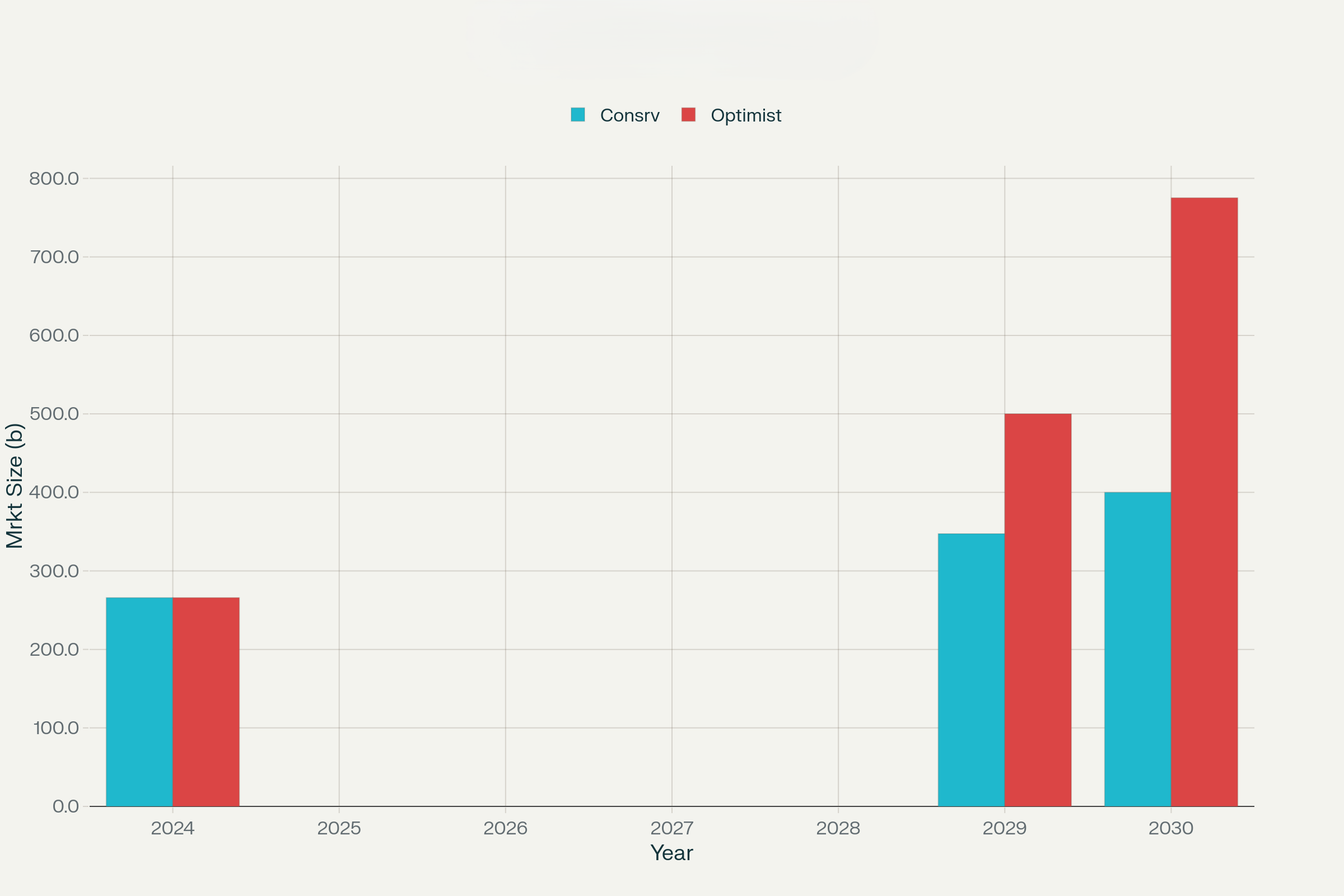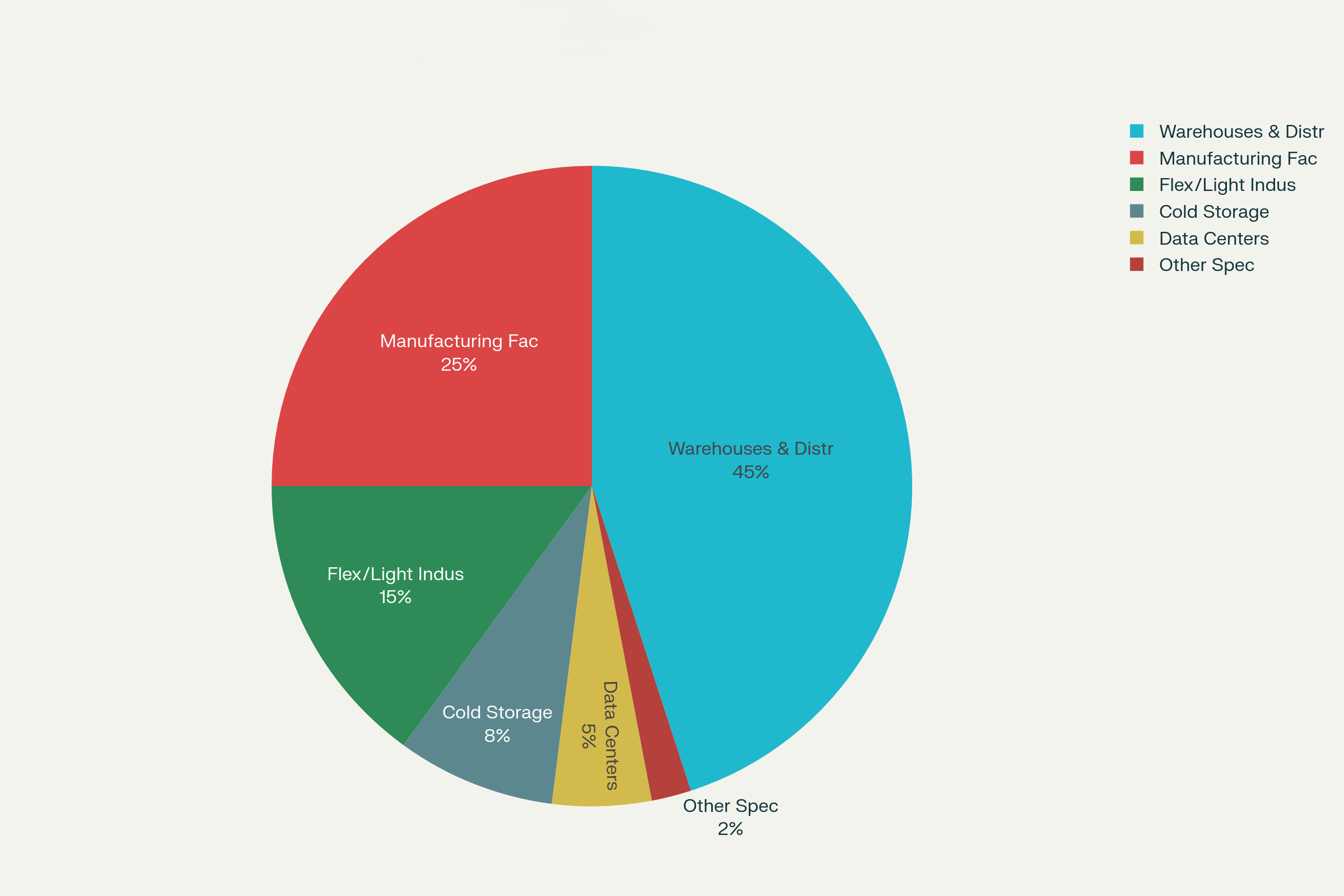Your Ultimate Guide to Industrial Real Estate Investment
Explore the Types of Industrial Properties, Investment Strategies, Key Drivers of Growth, and Expert Insights for Building Wealth Through Industrial Real Estatelast updated Thursday, September 11, 2025
#industrial real estate investment strategy #investing in industrial real estate
| | by John Burson | Content Manager, Paperfree Magazine |

QUICK LINKS
AD
Get Access to Real Estate Investment Opportunities
Industrial real estate represents one of the most lucrative and resilient investment opportunities in today's Market, with the global sector valued at $265.84 billion in 2024 and projected to reach $775.3 billion by 2030. This comprehensive guide covers every aspect of industrial property investment, from understanding market fundamentals to implementing successful investment strategies.
Understanding Industrial Real Estate Investing
Industrial real estate investing refers to investment in properties specifically designed and zoned to accommodate industrial activities such as manufacturing, production, assembly, warehousing, research, storage, and distribution of goods.
Industrial real estate operates within designated zones in cities, strategically separated from residential and commercial areas to prevent operational conflicts and maintain community harmony. This zoning approach ensures that heavy machinery, truck traffic, and industrial processes don't disrupt nearby businesses or neighbourhoods.
The rise of e-commerce has fundamentally transformed industrial real estate priorities. With consumer expectations shifting toward rapid delivery times—including same-day service—logistics companies are increasingly positioning their warehouses and distribution centres closer to urban populations. This trend, often called "last-mile logistics," has created high demand for industrial properties in metropolitan areas, driving innovation in warehouse design and urban planning to accommodate these evolving needs while managing space constraints and higher real estate costs.
 *Industrial Real Estate Market Growth Projections (2024-2030)
*Industrial Real Estate Market Growth Projections (2024-2030)
Market Size and Growth Trajectory
The industrial real estate market has demonstrated exceptional resilience and growth potential:
- Global market size 2024: $265.84 billion to $1.1 trillion (varying methodologies).
- Projected CAGR 2024-2030: 5.5% to 6.5%.
- Asia-Pacific dominance: 36.15% of global market share ($96.1 billion).
- Industrial transaction share: 39.6% of all commercial real estate transactions in 2024.
Best Performing Industrial REITs
1. Prologis, Inc. - PLD
2. Public Storage - PSA
3. Extra Space Storage Inc. - EXR
4. Lineage, Inc. - LINE
5. CubeSmart - CUBE
6. Rexford Industrial Realty, Inc. - REXR
7. EastGroup Properties, Inc. - EGP
8. First Industrial Realty Trust, Inc. - FR
9. STAG Industrial, Inc. - STAG
10. Terreno Realty Corporation - TRNO
Types of Industrial Real Estate Investment Properties
Industrial real estate is a dynamic sector offering diverse investment opportunities. With increasing demand across various industries, it's essential to understand the different types of industrial properties and their specific characteristics. Below are the primary industrial property types, their features, and the reasons why these categories are so attractive to investors.

*Industrial Real Estate Investment Types Breakdown by Property Category
1. Warehouses and Distribution Centres (45% of Market)
As the backbone of modern logistics, warehouses and distribution centers are in high demand, especially with the growth of e-commerce. These properties are crucial for the storage and rapid distribution of goods. The key attributes include:
- High Ceiling Heights
Typically ranging from 28 to 40 feet, providing ample space for stacking and storing goods. - Strategic Locations
Often located near transportation hubs, such as highways, ports, and airports, for efficient distribution. - Automation Integration
The rise of automated sorting systems and robotics has increased demand for state-of-the-art warehouses. - Last-Mile Delivery Capabilities
Proximity to urban areas enables quick deliveries, a growing need due to the surge in online shopping.
The demand for warehouses continues to rise as e-commerce giants such as Amazon and Walmart expand their distribution networks. With increasing online retail sales, warehouses remain a prime investment choice. According to a CBRE report, global industrial real estate is expected to experience steady growth in the coming years, making it a reliable option for long-term investors.
2. Manufacturing Facilities (25% of Market)
Manufacturing facilities serve as the heart of production for many industries, from automobiles to electronics. These properties are designed to support heavy machinery and large-scale production. Key characteristics include:
- Heavy Machinery Infrastructure: Properties equipped with specialised infrastructure to house production lines, large equipment, and machinery.
- Power-Intensive Needs: Manufacturing facilities often require significant energy resources, making them more suitable for areas with stable and affordable energy supplies.
- Regulatory Compliance: Many facilities must adhere to strict environmental and safety standards, which makes them attractive to investors looking for long-term stability.
These facilities are typically leased for long durations, offering stability and regular cash flow to investors. According to JLL, manufacturing and industrial property demand in North America is expected to grow significantly as production increases to meet domestic and international demand.
3. Flex and Light Industrial (15% of Market)
Flex spaces offer versatile properties that combine office space and light manufacturing or warehousing. These properties are ideal for businesses with evolving needs. Here's what makes them attractive:
- Adaptable Layouts
These properties can easily shift between warehouse, office, or light manufacturing uses, catering to various industries. - Lower Capital Requirements
Compared to larger manufacturing facilities, flex spaces typically have lower upfront costs. - Higher Rent Premium
Due to their adaptability, these properties often command premium rents from tenants who need flexible terms.
For small-to-medium enterprises (SMEs) and startups, flex and light industrial spaces provide the perfect environment to scale up operations. As businesses seek adaptable solutions, the demand for these properties continues to rise. The flexibility offered by these spaces makes them an appealing choice for businesses in dynamic sectors.
4. Cold Storage Facilities (8% of Market)
Cold storage facilities, which are designed for temperature-sensitive products, are increasingly in demand, especially in the food and pharmaceutical industries. Key features include:
- Temperature Control
These properties are equipped with advanced systems to store perishable goods at regulated temperatures. - Specialised Uses
Cold storage is essential for the storage of food, pharmaceuticals, and chemicals that require strict temperature management. - Premium Rental Rates
Given the specialized nature of cold storage, these facilities typically generate higher rental rates.
With the increasing demand for online food deliveries and pharmaceutical products, cold storage properties are becoming more valuable. As highlighted in a report by Knight Frank, cold storage investment is expected to rise, mainly due to growing global e-commerce and logistical demands.
Why Invest in Industrial Real Estate?
Industrial real estate offers a compelling case for investors looking for stability and high returns. Here's why industrial properties have become such an attractive investment option.
Superior Financial Performance
Industrial properties have historically outperformed other commercial real estate sectors, offering attractive financial returns:
- Rent Growth
Industrial rents saw a robust growth of 6.9% year-over-year in 2024. - Rental Spreads
Industrial properties continue to see strong rental spreads, averaging over 40% in some markets. - Consistent Returns
After four consecutive positive periods, industrial properties saw returns of 3.3% in recent quarters.
The demand for industrial space, particularly driven by e-commerce growth and supply chain restructuring, continues to fuel rent and price appreciation. CoStar highlights that demand for industrial properties is outpacing supply in major global markets, pushing rental rates higher.
E-Commerce and Supply Chain Drivers
The surge in online shopping has been a major driver of industrial real estate demand. Key trends include:
- E-Commerce Growth
The e-commerce sector is expected to grow by 9% annually, which directly boosts demand for warehouses and distribution centres. - Supply Chain Resilience
In response to global disruptions, companies are investing in domestic industrial capacity, strengthening the appeal of industrial assets. - Automation
The increased adoption of automation technologies in warehouses is creating a demand for state-of-the-art facilities that support robotic systems and AI.
As companies look to streamline their supply chains, the demand for industrial real estate will likely continue to rise. According to a report by JLL, the demand for warehouse and distribution space is expected to remain high throughout the next decade.
Favourable Market Fundamentals
Industrial properties benefit from strong market fundamentals, including:
- Low Vacancy Rates
National vacancy rates for industrial real estate are between 6.4% and 7.5%. - Limited New Supply
In 2024, only 330.7 million square feet of new industrial space were delivered, highlighting supply constraints. - Strong Tenant Creditworthiness
Many industrial leases are long-term and backed by investment-grade tenants, making them a stable income-generating asset.
These factors contribute to the stability of industrial real estate, even during economic downturns.
Industrial Real Estate Investment Strategies
Understanding the various investment strategies can help investors tailor their portfolios to align with their risk tolerance and financial goals. Below are the most common industrial real estate investment strategies.
Core Investment Strategy
The core investment strategy focuses on high-quality, stabilized properties with strong tenants, minimal capital improvement needs, and predictable cash flows. Ideal for conservative investors, core properties include:
- Class A distribution centers
- Modern manufacturing facilities
- Long-term lease properties
These properties typically offer returns of 6-8% annually. CBRE suggests that these types of properties provide consistent income generation with low volatility.
Explore all Real estate investment strategies to grow and preserve wealth.
Value-Add Strategy
Investors using the value-add strategy focus on acquiring underperforming properties and improving their operational efficiency.
By upgrading facilities or enhancing tenant mixes, investors aim to generate higher returns (10-15%). Some common value-add opportunities include:
- Modernizing facilities
- Restructuring leases
- Improving operational efficiency
This strategy offers the potential for higher returns but also comes with increased risk. NAIOP emphasizes that this strategy requires a deep understanding of property management and market conditions.
Opportunistic Strategy
The opportunistic strategy is a high-risk, high-reward approach. It involves investing in distressed properties or development projects in high-growth markets. Returns of 15-20%+ are targeted. This strategy often includes:
- Ground-up construction
- Development in supply-constrained markets
- Distressed asset acquisitions
Opportunistic investors must be willing to navigate market volatility and capitalize on emerging opportunities.
Top Industrial Real Estate Investment Companies
Several investment firms and funds specialize in industrial real estate, offering a range of options for both public and private investors.
Public REITs
- Prologis (PLD)
Specializes in logistics real estate with a global portfolio valued at over $197.5 billion. - EastGroup Properties (EGP)
Focuses on Sunbelt markets with a growing development pipeline. - STAG Industrial (STAG)
Diversified industrial portfolio with a value-driven investment approach.
Private Equity Firms
- KPS Capital Partners specializes in manufacturing and industrial companies with $21.4 billion in assets under management.
- CORE Industrial Partners: Focuses on operational improvements in the lower middle Market with $1.58 billion in committed capital.
Specialized Fund Managers
Industrial Property Investment Fund (IPIF):
A UK-focused fund with over £2 billion in assets, specializing in multi-let properties.
These firms and funds offer different entry points for investors, whether they prefer the stability of publicly traded REITs or the hands-on approach of private equity.
Industrial-Focused Private Equity Firms
Industrial-focused private equity firms specialize in investing in and managing industrial companies and properties. These firms typically acquire, improve, and expand manufacturing, logistics, or distribution companies to drive operational efficiencies and increase profitability. They focus on industries such as manufacturing, construction, and logistics that are vital to the global economy.
Key Characteristics of Industrial-Focused Private Equity Firms:
- Target Industries
These firms usually target industrial sectors such as manufacturing, logistics, automation, construction, and supply chain services. Their goal is to optimize the performance of these companies and properties by implementing operational improvements, expanding market reach, and increasing technological integration. - Long-Term Investment Horizon
Industrial-focused private equity firms typically invest with a long-term perspective, aiming to generate value through strategic management, process optimization, and capital improvements. Their investments are generally held for 3-7 years before being sold or taken public. - Active Involvement
Unlike passive investors, private equity firms often take an active role in the operations of the businesses they acquire. They may bring in experienced management teams, implement new technologies, or expand production capacities to improve efficiency and growth.
Top Industrial Focused Private Equity Firms
KPS Capital Partners:
- Assets Under Management (AUM): $21.4 billion
- KPS Capital specializes in industrial and manufacturing companies, focusing on acquiring and improving businesses within these sectors. They focus on controlling equity investments, implementing operational improvements, and driving value creation.
CORE Industrial Partners:
- AUM: $1.58 billion
- CORE targets North American manufacturing companies, particularly in the lower middle market. The firm works with businesses to enhance operational performance and create long-term growth through investments in plant and equipment, automation, and global expansion.
Blackstone:
- AUM: $602 billion
- Blackstone is one of the largest private equity firms globally and has a significant presence in industrial real estate. It invests in diversified industrial portfolios and has a dedicated fund focusing on logistics, manufacturing, and supply chain companies.
Carlyle Group:
- AUM: $293 billion
- The Carlyle Group focuses on investing in global industrial companies, particularly those in the manufacturing and infrastructure sectors. They seek to improve performance through operational restructuring, acquisitions, and technological integration.
TPG Capital:
- AUM: $96 billion
- TPG is another major player in industrial private equity, investing in industries like manufacturing, energy, and logistics. They have a history of using technological upgrades and sustainability initiatives to drive profitability and market competitiveness.
How Industrial Private Equity Firms Create Value:
- Operational Improvements
Industrial-focused private equity firms often focus on optimizing supply chains, improving production processes, and upgrading technologies. They may implement lean manufacturing practices or invest in automation to increase efficiency and lower costs. - Strategic Acquisitions
Industrial private equity firms also grow their portfolio companies by making strategic acquisitions that complement or expand existing operations. This can include acquiring competitors or related businesses to create a more integrated value chain. - International Expansion
Some industrial-focused private equity firms invest in expanding operations into new markets, including global markets. This can increase revenue streams and reduce exposure to domestic market volatility.
Industrial-focused private equity firms provide an essential link in the investment world by focusing on industrial sectors that support the global supply chain. With active management, they aim to improve operations and increase the value of their investments over time.
How to Invest in Industrial Real Estate
Investing in industrial real estate can be an attractive option for investors seeking stable returns and diversification in their portfolio. To begin investing in industrial real estate, follow these key steps:
1. Understand the Market:
- Research
Before investing, it's crucial to understand the market dynamics, including trends in e-commerce, manufacturing, logistics, and supply chains. Familiarize yourself with market reports, such as those from CBRE or JLL, which provide detailed insights into industrial property trends. - Location Analysis
Industrial real estate investments are highly dependent on location. Look for properties near transportation hubs like ports, airports, highways, and railroads, as these areas offer the best accessibility for logistics and distribution.
2. Choose Your Investment Vehicle:
- Direct Investment
This involves purchasing industrial properties directly, either for development, leasing, or resale. Direct ownership requires substantial capital and expertise in property management, but it allows for complete control over the asset. - Real Estate Investment Trusts (REITs)
If you prefer a more hands-off approach, consider investing in industrial REITs, which pool funds to invest in a diversified portfolio of industrial properties. Publicly traded REITs such as Prologis are ideal for investors looking for liquidity and a low barrier to entry. - Private Equity Firms
Investing through private equity firms that focus on industrial properties can also be an option. These firms typically acquire, manage, and optimize industrial assets to generate returns. Examples include CORE Industrial Partners.
3. Secure Financing:
- Commercial Mortgages
Traditional commercial loans are standard for purchasing industrial properties, with longer terms and higher loan-to-value ratios than residential mortgages. - SBA Loans
The SBA 7(a) and SBA 504 programs are excellent options for those buying owner-occupied industrial properties. These loans offer lower interest rates and longer repayment terms. - Bridge Loans
If you are purchasing a distressed property or need fast capital, bridge loans can provide short-term financing to close deals quickly.
3. Due Diligence:
- Physical Inspections
Inspect the property for its structural integrity, load-bearing capacity, and compliance with zoning and environmental regulations. - Market Analysis
Assess the rental rates, vacancy rates, and tenant quality. Evaluate the potential for capital appreciation based on long-term market trends.
Why Invest in Industrial Real Estate?
Industrial real estate offers numerous benefits, making it an appealing investment for those seeking stability and consistent returns. Here are some reasons why you should consider investing in this asset class:
- Strong Demand Driven by E-Commerce
The growth of e-commerce has dramatically increased the demand for warehouse and distribution centers. According to CBRE, global e-commerce sales are expected to continue growing, which drives the need for more industrial space. - Higher Yield Potential
Industrial properties generally offer higher rental yields than other types of commercial real estate. As per recent data, industrial real estate has been outperforming other sectors in terms of both rent growth and capital appreciation. - Stability and Lower Volatility
Industrial real estate is considered more stable than other types of commercial properties because tenants often sign long-term leases (10 years or more). Additionally, demand for warehouse and logistics spaces remains consistent, as these properties are essential to supply chains and manufacturing. - Inflation Hedge
Industrial real estate can act as a hedge against inflation. Rent increases tied to inflation or periodic lease renewals protect against the erosion of purchasing power, making industrial properties attractive in times of economic uncertainty. - Tax Benefits
Investors in industrial real estate can take advantage of various tax benefits, including depreciation deductions, which can offset taxable income. Additionally, many industrial properties qualify for opportunity zone investment incentives, offering tax incentives for investing in economically distressed areas.
Best Industrial Real Estate Investment Strategy
When it comes to investing in industrial real estate, having a solid strategy is key to maximizing returns and minimizing risk. Here are the top strategies investors use:
1. Core Strategy (Stabilized Assets)
This strategy involves investing in high-quality, fully leased industrial properties with stable tenants and predictable cash flow. These properties are usually low-risk and are located in prime markets. The focus is on generating consistent rental income with minimal management intervention. Investors often target Class A warehouses and distribution centers that have long-term lease agreements.
2. Value-Add Strategy
Investors who choose the value-add strategy acquire properties that require some form of improvement, whether in terms of renovations, tenant upgrades, or operational efficiency improvements. By improving the property’s condition or tenant mix, the investor can command higher rental rates and improve the overall value of the property. This strategy typically offers a higher return potential (10-15%) but requires active management.
3. Opportunistic Strategy
This high-risk, high-reward strategy involves investing in distressed or underperforming industrial properties that require significant rehabilitation or repositioning. Opportunistic investors typically look for assets in emerging markets or undergoing redevelopment to capitalize on future growth. These investments are generally more speculative and may include ground-up construction or acquisitions in underserved areas.
4. Development Strategy
Investors using the development strategy build new industrial properties or undertake significant redevelopment projects in supply-constrained areas. This strategy often requires more capital and time but offers the potential for high returns, particularly in markets experiencing a lack of available industrial space. Investors in this strategy should pay close attention to market conditions and future demand trends.
5. REIT Strategy
Real Estate Investment Trusts (REITs) allow investors to diversify their portfolios by investing in a basket of industrial properties without owning them directly. REITs like Prologis allow investors to buy shares in large portfolios of industrial properties, including warehouses, manufacturing facilities, and distribution centers. This strategy offers liquidity and lower upfront capital requirements compared to direct investments.
Bottom Line: Investing in Industrial Real Estate | Tips for Success
- Focus on Long-Term Growth
An industrial real estate investment fund typically requires a long-term perspective. Look for properties in areas with strong growth potential, whether due to infrastructure development, population growth, or business expansion. For example, areas near new transportation hubs or distribution centers can offer long-term upside potential. - Diversify Your Portfolio
Diversification is a key element in any investment strategy. Consider diversifying across different types of industrial properties (e.g., warehouses, manufacturing, and flex spaces) and geographic regions to minimize risks. - Keep an Eye on Market Trends
Stay updated on global and local industrial real estate trends. - Due Diligence is Critical
Thorough due diligence is essential in industrial real estate investing. Continually evaluate the physical condition of the property, the quality of tenants, and the overall market dynamics before making a purchase. This includes legal checks, financial assessments, and environmental audits.
Frequently Asked Questions
1. Is industrial real estate a good investment?
Yes, industrial real estate offers strong returns with stable, long-term leases and growing demand driven by e-commerce and logistics trends.
2. What types of industrial properties generate the best returns?
Warehouses and distribution centers typically provide the highest yields, especially modern facilities near transportation hubs.
3. How does industrial real estate compare to residential or office investments?
Industrial real estate generally delivers higher risk-adjusted returns with lower volatility compared to residential or office properties.
4. What are the typical investment minimums for industrial real estate?
Direct ownership often requires millions in capital, but investors can access the sector through industrial REITs or crowdfunding with lower minimums.
5. Which markets currently show the strongest industrial real estate growth?
Key markets include the Inland Empire (CA), Dallas-Fort Worth, Atlanta, Savannah, and Los Angeles, driven by logistics demand and population growth.
6. What are the main risks, and how can investors mitigate them?
Risks include economic downturns, tenant concentration, and market volatility. Diversification, choosing recession-resistant tenants, and focusing on prime locations help mitigate risks.
Related Pages
- 4 Ways to Better Organize Inventory Management

- How to Spot and Avoid Hard Money Scams

- Hard Money Jumbo Loans in 2025: Latest CFPB Updates & Analysis

- 5 Common Mistakes to Avoid When Investing in Real Estate

- Are You Paying Too Much for a Real Estate Investment Property?

- Hard Money Loan Brokers and Wholesalers

- The Lender Checklist: Finding a Solid Real Estate Investment

- 3 Types of Bad Credit Commercial Hard Money Lenders

Popular Page
Private Real Estate Funds - Investments to Drive Income and Capital Growth
Book a Free Complimentary Call
Search within Paperfree.com
real estate investing Investment Visa USA Investment Magazine Private Real Estate Funds real estate funds
